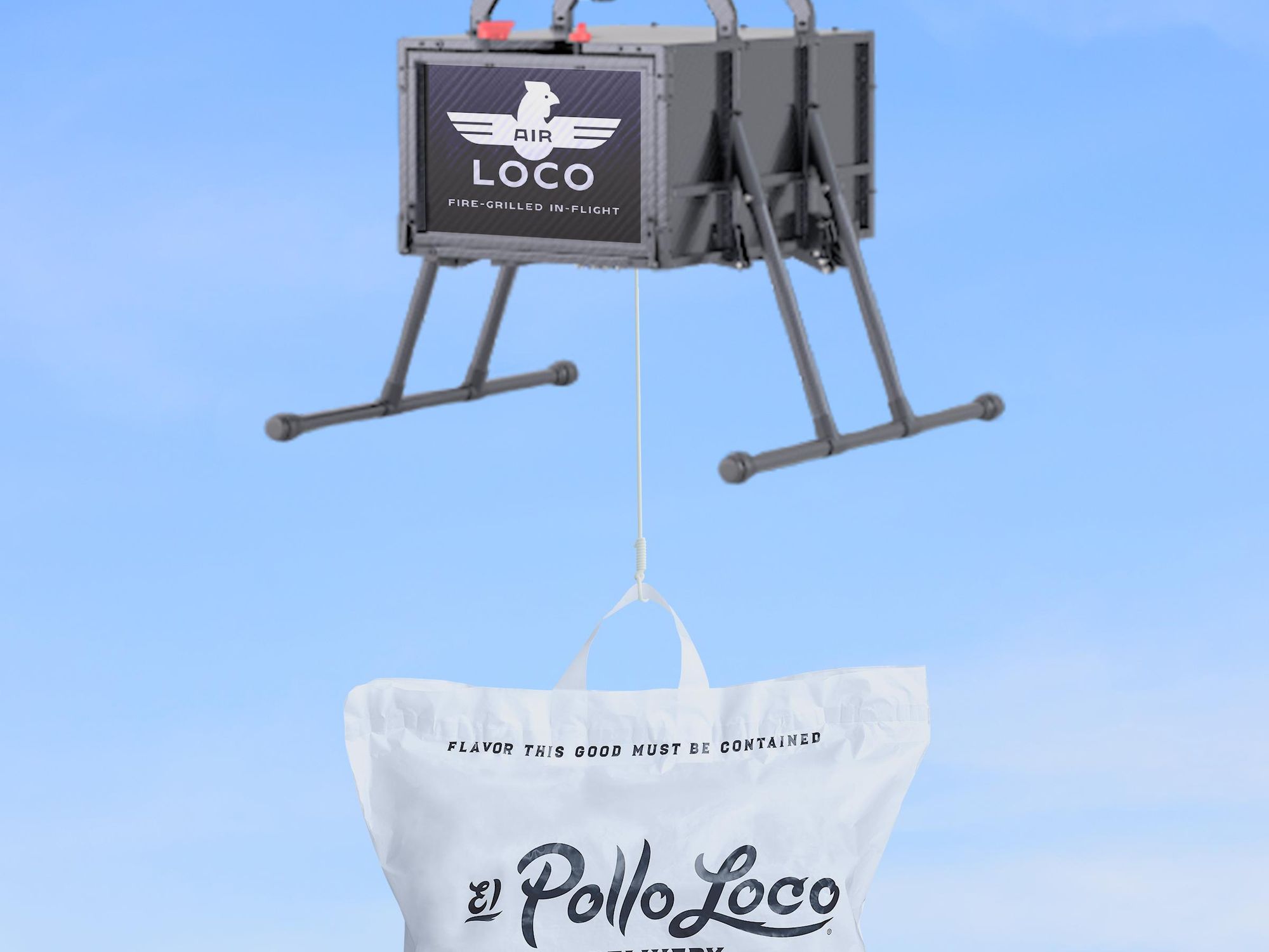El Pollo Loco Tests 'Air Loco' Drone Delivery Despite Concerns

For the last five months, orders of grilled chicken have zipped through the skies of Costa Mesa.
In June, restaurant chain El Pollo Loco launched a drone delivery program in the city of about 113,000, which also serves as the site for its corporate headquarters. While other companies have piloted drone programs that deliver to pickup sites, El Pollo Loco was aiming to become one of the first to deliver food to backyards.
Their delivery drones ascend to about 200 feet, and lower chicken deliveries using an 80-foot wire to people’s homes.
From the perspective of Andy Rebhun, the vice president of digital at El Pollo Loco, the company has had “an unprecedented'' amount of customer interest in the service, measured by new signups to the company’s drone delivery landing page, airloco.com. Rebhun wouldn’t disclose the number of completed drone deliveries or how many people have signed up for the program, but said the latter was a “six-figure number.”
“Once we shared the story of our first deliveries, it got massive interest on all our social media channels and several videos had over a million organic views,” he said.
The arrangement is likely to become more common in the coming years.
El Pollo Loco is far from the only company to dive into the world of drone delivery. Last week Walmart announced the launch of a drone delivery pilot program in Farmington, Arkansas.
El Pollo Loco’s program is run in partnership with Flytrex, an Israeli drone delivery startup that in November raised $40 million in Series C funding. Other companies have started to run pilot programs featuring the company’s drone tech, too. Some Brinker International restaurants like Chili’s, It’s Just Wings and Maggiano’s Little Italy piloted drone programs with Flytrex in North Carolina.
Across all of those programs, Flytrex CEO and co-founder Yariv Bash said the company has completed “thousands of deliveries,” the bulk of which have come in the past few months (the company claims to be doing 10 times more deliveries now than it was doing at the beginning of 2021).
So far, Bash said “thousands” of people have registered for Flytrex’s delivery app – though most of their homes aren’t in range to receive drone deliveries, he said. But those who are in range tend to be repeat customers, which accounts for the number of deliveries.
“So far, more than 50% of people who have registered use three deliveries or more. It’s pretty viral – people really love it,” he said.
Just 2% of restaurants use drone delivery, though 10% appear to be interested in incorporating them, the report found. But there does seem to be some interest in drone delivery from consumers: 38% of consumers expressed interest in the service.
However, drone delivery isn’t always well-received. A drone delivery program run by Wing (Alphabet’s drone delivery company) in Canberra, Australia led to noise complaints in 2018. An Australian government analysis also upheld that the drones were breaking the neighborhood’s noise standards of 45 decibels, and had a “particular pitch” that is more noticeable. Wing has since debuted a quieter drone.
There are concerns in the U.S., too. In one U.S.-based survey of 801 phone interviews run by the public affairs company the Hawthorne Group, 51% of consumers supported neighborhood drone deliveries. But, 48% were still “somewhat concerned” about safety, and 71% were concerned about privacy.
That said, some U.S. communities with drone delivery programs are reporting positive results. A study conducted by scientists at Virginia Tech, for example, found that 87% of surveyed residents had positive feelings towards drone delivery programs. During the pandemic, the study found that positive feelings increased in 58% of residents.
The authors of that study suggested that opinions of drone delivery may be higher in communities that experience it (though that hasn’t necessarily been the case in Australia).
As for restaurants, Ann Golladay, an associate director at Datassential, said that once people experience new technology, attitudes also tend to change in positive ways.
“We've found in our research that consumers are generally opposed to new technology until they use it, and then satisfaction is high and it is well-loved,” Golladay, told dot.LA.
The pandemic, she adds, has only made consumers more open to new forms of technology in restaurants.
The Costa Mesa City Council, a host city for the El Pollo Loco drone project, did not return multiple requests for comment for this story. But Aaron Levitt, the principal engineer in the town of Holly Springs, North Carolina, which just introduced a similar Flytrex restaurant delivery program, did note that residents have been receptive.
“We did have a lot of reactions. The majority were very positive and very excited,” he told dot.LA.
Holly Springs has earned membership in an FAA pilot program aimed to facilitate drone programs. Flytrex is running drone deliveries through a launch station at a nearby shopping center; restaurants simply drop off orders at the launch station, and the drone takes it from there.
Building community trust in a drone project came down to two large factors: noise and privacy.
“The typical response you would get from the people that were not really so sure or who were negative about it was: they’re going to be spying on me,” said Levitt. “And as soon as you say there's no cameras on the drones, everyone just relaxes.” (Flytrex drones do not have any cameras, a spokesperson confirmed.)
As for noise, Levitt requested that Flytrex run specific tests to ensure that the drones wouldn’t become excessively loud. The results of those tests showed the drone is about 66 decibels loud during active delivery, about as loud as a normal conversation or an active office. It’s 55 decibels loud while flying overhead en route to delivery – as loud as a household refrigerator.
Levitt’s hope for drone deliveries is that they can eventually make deliveries to workers at a nearby business park, who are looking for nearby food options. He also sees it as a perk that may excite other large companies like Amgen, who is building a facility in Holly Springs, to come to town. He also hoped drones would become useful for small businesses close to the launch site – though those partnerships have yet to materialize.
“Maybe a mom-and-pop sort of restaurant could use Flytrex as a delivery option. Eventually, I think that’s going to be a real thing, where any of those restaurants in that area could utilize them as delivery and you know, maybe help grow a business,” he said.
Ultimately, drone delivery still has a long way to go to live up to the hype surrounding it. But so far, enthusiasm appears high. Rebhun, for one, said drones are “absolutely” part of El Pollo Loco’s strategy going forward, though they are still evaluating the program.
“We have no reason not to welcome the technology as a more permanent part of business,” he said.
- Hundreds of Delivery Robots Are Coming to Los Angeles - dot.LA ›
- At UCLA, Robots Are Delivering Groceries, Pizza and Coffee - dot.LA ›
- Los Angeles Wants Drone Delivery by 2023 - dot.LA ›
- El Pollo Loco Launches a Backyard Drone Delivery Program - dot.LA ›





 Image Source: Perelel
Image Source: Perelel